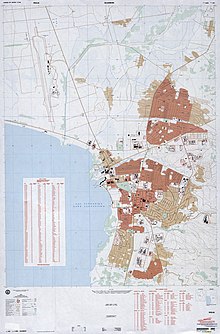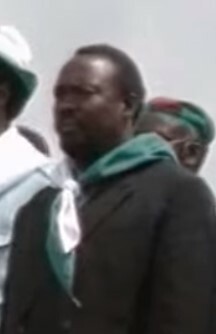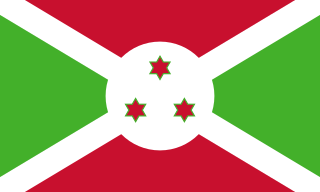| History of Burundi |
|---|
 |
The following is a timeline of the history of the city of Bujumbura, Burundi.
| History of Burundi |
|---|
 |
The following is a timeline of the history of the city of Bujumbura, Burundi.



The Politics of Burundi takes place in a framework of a transitional presidential representative democratic republic, whereby the President of Burundi is both head of state and head of government, and of a multi-party system. Executive power is exercised by the government. Legislative power is vested in both the government and the two chambers of parliament, the Senate and the National Assembly.
The BurundiNational Defence Force is the state military organisation responsible for the defence of Burundi.

Bujumbura, formerly Usumbura, is the economic capital, largest city and main port of Burundi. It ships most of the country's chief export, coffee, as well as cotton and tin ore. Bujumbura was formerly the country's political capital. In late December 2018, Burundian president Pierre Nkurunziza announced that he would follow through on a 2007 promise to return Gitega its former political capital status, with Bujumbura remaining as economical capital and center of commerce. A vote in the Parliament of Burundi made the change official on 16 January 2019, with all branches of government expected to move to Gitega within three years.

Cyprien Ntaryamira was a Burundian politician who served as President of Burundi from 5 February 1994 until his death two months later. A Hutu born in Burundi, Ntaryamira studied there before fleeing to Rwanda to avoid ethnic violence and complete his education. Active in a Burundian student movement, he cofounded the socialist Burundi Workers' Party and earned an agricultural degree. In 1983, he returned to Burundi and worked agricultural jobs, though he was briefly detained as a political prisoner. In 1986 he cofounded the Front for Democracy in Burundi (FRODEBU), and in 1993 FRODEBU won Burundi's general elections. He subsequently became the Minister of Agriculture and Animal Husbandry on 10 July, but in October Tutsi soldiers killed the president and other top officials in an attempted coup.

Burundi is divided into eighteen provinces, each named after their respective capital with the exception of Bujumbura Rural.

Bujumbura Mairie Province is one of the eighteen provinces of Burundi. It consists entirely of the city of Bujumbura, Burundi's former capital.

Jean-Baptiste Bagaza was a Burundian army officer and politician who ruled Burundi as president and de facto military dictator from November 1976 to September 1987.

The Burundian Civil War was a civil war in Burundi lasting from 1993 to 2005. The civil war was the result of longstanding ethnic divisions between the Hutu and the Tutsi ethnic groups. The conflict began following the first multi-party elections in the country since its independence from Belgium in 1962, and is seen as formally ending with the swearing-in of President Pierre Nkurunziza in August 2005. Children were widely used by both sides in the war. The estimated death toll stands at 300,000.

Islam is a minority religion in Burundi where approximately 90 percent of the national population are followers of Christianity. Between 2–5 percent of the population identifies as Muslim, according to a 2010 estimate by the United States Department of State. The same year, the Pew Research Centre estimated that there were 230,000 Muslims in Burundi, equivalent to 2.8 percent of Burundi's 8.4 million inhabitants.

Léopold Bihumugani or Biha (1919–2003) was a Burundian politician who served as Prime Minister of Burundi from 13 September 1965 until 8 July 1966. A Ganwa born to a chief in Ruanda-Urundi, he became a close confidant of Mwami Mwambutsa IV in the 1940s after being given charge of a chiefdom which included some of the monarch's property. In the late 1950s he became involved in the Union for National Progress (UPRONA) party as the Belgian colonial administration prepared to grant Burundi its independence. Biha left the party after becoming disenchanted with leader Louis Rwagasore's populist style, and held different roles in transitional governments. He created a new party, Burundi Populaire, but failed to get elected to office and was appointed private secretary to the Mwami after independence.

The following outline is provided as an overview of and topical guide to Burundi:
Joseph Cimpaye was a Burundian politician and writer.

Burundi, officially the Republic of Burundi, is a landlocked country in the Great Rift Valley at the junction between the African Great Lakes region and East Africa. It is bordered by Rwanda to the north, Tanzania to the east and southeast, and the Democratic Republic of the Congo to the west; Lake Tanganyika lies along its southwestern border. The capital cities are Gitega and Bujumbura, the latter being the country's largest city.
These are some of the articles related to Burundi on the English Wikipedia:
Prostitution in Burundi is illegal but is commonplace and on the rise. Prostitution is prevalent in all areas of the country, and especially in the largest city, Bujumbura, and prior to the security crisis in 2015, the tourist areas around Lake Tanganyika. UNAIDS estimate there are 51,000 prostitutes in Burundi. Many women have turned to prostitution due to poverty.

The commune of Buyenzi is a historic commune (District) of Bujumbura Mairie Province in western Burundi. The district us known for its Swahili heritage and influence not just in Bujumbura but Burundi as a whole. Buyenzi communie is laid on a grid plan and has 25 horizontal numbered streets.
The following is a timeline of the history of the city of Yaoundé, Cameroon.
Clotilde Niragira was a Burundian politician and lawyer. She served as head of three separate ministries in Pierre Nkurunziza's government and was Secretary-General of Burundi's Truth and Reconciliation Commission.

The Ikiza, or the Ubwicanyi (Killings), was a series of mass killings—often characterised as a genocide—which were committed in Burundi in 1972 by the Tutsi-dominated army and government, primarily against educated and elite Hutus who lived in the country. Conservative estimates place the death toll of the event between 100,000 and 150,000 killed, while some estimates of the death toll go as high as 300,000.
Martin Ndayahoze was a Burundian military officer and government official who served variously as Minister of Information, Minister of Economy, and Deputy Chief of Staff of the Burundian National Army. He was the only Hutu military officer to serve in government under President Michel Micombero and frequently warned of the dangers of ethnic violence in his reports to the presidency. He was executed in 1972.